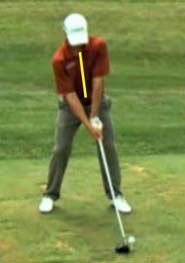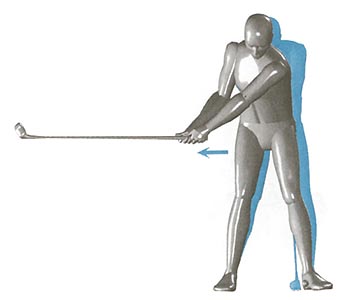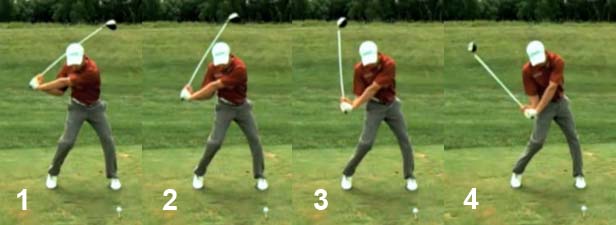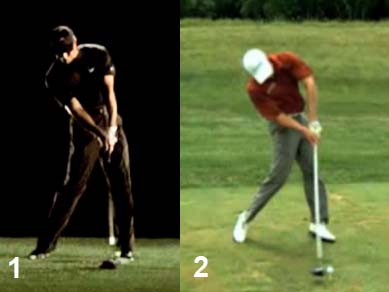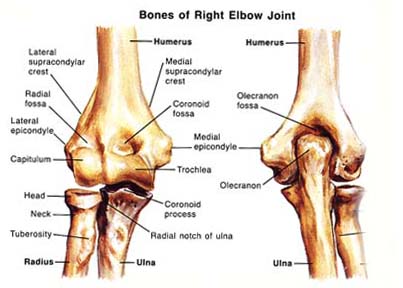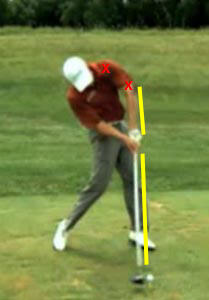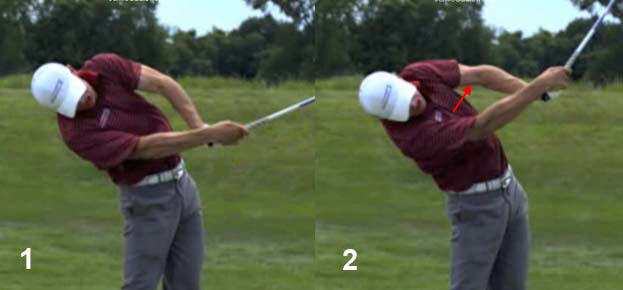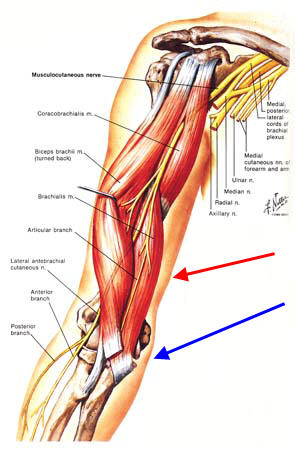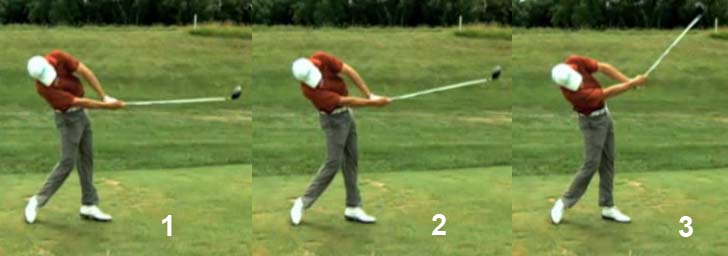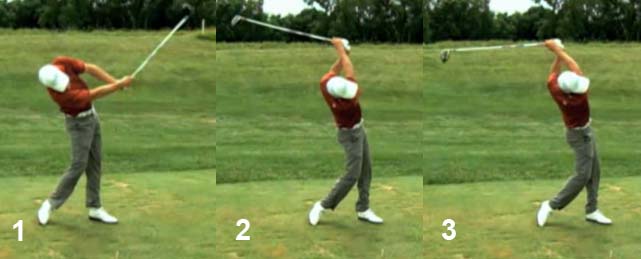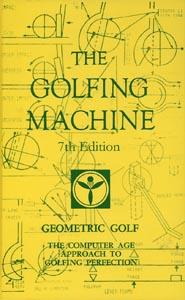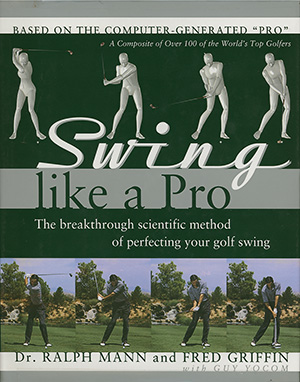Click here to go to the index page.
Introduction:
In this review paper, I will be discussing the biomechanics/mechanics of Jamie Sadlowski's driver swing.
Who is Jamie Sadlowski? Jamie Sadlowski is now very well-known to followers of long-drive competition events, and he is the current reigning world champion [1]. He recently won the RE/MAX 2008 World Long-Drive Championship event [2]. When one first sees Jamie Sadlowski, it is hard to believe that he is the world long-drive champion. He is 5'11" in height and he only weighs 165 lbs. In terms of body physique, he seems puny in comparison to many other first-class long-drive competitors (eg. Jason Zuback). One therefore wonders how he can drive the ball further than his fellow competitors. However, when one sees his swing for the first time, one is immediately dazzled by the speed of his swing. He rotates his body and arms/clubshaft so fast, that his swing appears to be a biomechanically-undecipherable "blur" when viewed at a normal/natural "real life" speed. I initially could never clearly understand the fundamental biomechanics/mechanics responsible for his awesome driving performance (>400 yards drives), because his swing was too fast to properly analyse using my V1 Home Swing Analyser program. There were too many "missing frames" when viewing a swing video captured at a standard video speed of 30-60 frames/second. I eventually found a slow-motion U-tube swing video of his driver swing that was photographed with the Konica BizHub SwingVision camera system [3], and I was finally able to analyse his swing biomechanics/mechanics in great depth. In this review paper, I will be freely sharing my personal insights regarding Jamie's swing biomechanics/mechanics with this website's visitors, who are interested in learning how he can drive the ball so far.
I am going to be referring to Homer Kelley's power accumulator loading/release concepts [4] in this review paper, and readers who are unfamiliar with these TGM-concepts should first read my "How to Power the Golf Swing" review paper, so that they can understand my in-depth swing analysis. From a swing power perspective, the first question one needs to answer regarding Jamie Sadlowski's swing is whether he is a swinger or a hitter. Jamie Sadlowski is definitely a left-arm swinger and he uses a pivot-drive action to activate and release the master power accumulator (PA#4). In a left arm swinger's action, the standard swing action involves the use of three power accumulators in a set sequence (4:2:3) and it is therefore called a triple barrel swing action. However, Jamie Sadlowski only uses two power accumulators in a standard release sequence of 4:2 and he therefore has a double barrel swing action. Jamie Sadlowski does not use PA#3 (called the transfer power accumulator) because he does not use any hand-roll over action in his backswing or downswing, and he also does not use PA#1 (active right arm straightening action that drive-loads the clubshaft). It is amazing that he can drive the ball >400 yards using only two of the four power accumulators that are biomechanically available to a golfer, but his loading/release of PA#4 and PA#2 are super-efficient, and his swing is an example of super-efficient golf biomechanics (operating in accordance to the basic principle of the double pendulum swing model - see reference number [5]).
Jamie Sadlowski has a particular swing idiosyncrasy that has a major effect on his swing biomechanics, and that is his tendency to have i) a strong left hand grip (4 knuckle grip) and his associated anatomical tendency to have ii) an internally rotated left arm at address. Those anatomical choices means that he doesn't use any left forearm pronatory swivel movement in the takeaway (takeaway swivel action) and he therefore doesn't use a left forearm supinatory swivel movement (release swivel action) during the late downswing. The fact that his left arm is internally rotated at address, and therefore at impact, is responsible for the fact that he "chicken-wings" his left arm in the late downswing, at impact, and in the followthrough. It also is responsible for the fact that he doesn't use a horizontal hinging action in the followthrough. I will discuss all these facts/issues in greater detail in a later section of this review paper.
I am now going to describe his swing biomechanics/mechanics in the different phases of his swing.
Address position:
Jamie Sadlowski has a standard address posture that is characteristic of a traditional left arm swinger.
Jamie Sadlowski at address - capture image from his swing video [3]
At address, Jamie Sadlowski has a small degree of rightwards spinal tilt (see yellow line). That causes his head to be behind the center of his stance and well behind the ball. His legs are wide apart - slightly wider than shoulder width and his feet are splayed open about 10 degrees. His pelvis and knees and shoulders are square to the ball-target line.He holds his hands centrally, and his clubshaft and left arm are therefore not in a straight line relationship at address.
Most importantly, note that the back of his left hand is facing skywards (facing the ball-target line) at address - due to a very strong left hand grip (4 knuckle grip). This causes his left hand to appear scooped/cupped at address, and the degree of scooping/cupping is increased due to the fact that his left wrist is also bent (slightly dorsiflexed) because the left arm and clubshaft are not in a straight line relationship.
Also most importantly, note that his left upper arm is internally rotated in the left shoulder socket joint and that anatomical phenomenon causes the dorsum (back) of his left forearm to face the ball-target line (rather than the target) at address, and it also causes his left elbow's antecubital fossa (hollow in front of the left elbow joint) to face away from the target (rather than face the ball-target line). This anatomical fact will have a significant affect when his left arm gets back to that same position at impact - and it is causally related to the fact that he "chicken-wings" his left arm at impact.
Backswing:
Jamie Sadlowski uses a standard one-piece takeaway at the start of his backswing action.
Jamie Sadlowski's backswing sequence - capture images from his swing video [3]
Images 2 and 3 show that Jamie Sadlowski uses the standard one-piece takeaway, where he tries to keep the right arm relatively straight during the takeaway - note that the right elbow has only a small degree of bend at the end of the takeaway (image 3). That arm movement, where the right arm moves away from the right side of the torso, creates a "feeling" of creating width in the backswing.Note that the clubface is still facing slightly towards the ball at the end-takeaway position (toe of the club is not pointing straight up towards the sky) - and that is due to the fact that he does not utilise any left forearm rotary/pronatory movement in his takeaway (as occurs in a standard left arm swinger's action). His left arm is already internally rotated at address, and he simply pulls his internally rotated left arm back away from the target during the takeaway.
During his one-piece takeaway, he allows his shoulders to naturally turn perpendicularly around his rightwards tilted spine, and that causes his shoulder turn to be relatively horizontal (left shoulder is only slightly lower than the right shoulder).
Many professional golfers allow their pelvis to sway 1-3" to the right during the early backswing, as described by the SLAP researchers in their study of professional golfers' swings [5].
Pelvic sway during the backswing - as described/recommended by the SLAP authors [5]
Many professional golfers have a centralised pelvis at address, and they allow their pelvis to sway a few inches to the right in the early backswing. Many golf instructors, including David Leadbetter and the SLAP authors, recommend this small degree of pelvic sway action during the takeaway. I now personally think that is biomechanically advantageous to not allow the pelvis to sway rightwards in the early backswing, and I think that is biomechanically better to simply withdraw the right buttocks (pull the right buttocks back away from the ball-target line) while keeping the right knee slightly flexed throughout the backswing. Jamie Sadlowski adopts this practice and he doesn't allow his pelvis and right knee to sway rightwards (away from the target) during his backswing. Note that the outer border of his right pelvis is well within the inner border of his right foot at the end of his backswing (image 6).Image 4 shows Jamie Sadlowski in his mid-backswing - when his left arm is horizontal to the ground. His clubshaft is on-plane - an imaginary line extending from the butt end of his club points at the ball-target line. However, note that his clubface is relatively closed to his clubhead arc, and that is due to the fact that he doesn't utilise a takeaway swivel action. Note that his left wrist has upcocked to nearly a 90 degree angle and that phenomenon is causally related to the fact that he is allowing his right elbow to start bending much more during the mid-backswing. Also, note that his right wrist is bending backwards (dorsiflexing) without cocking upwards and that biomechanical phenomenon allows him to keep his clubshaft on-plane in his mid-backswing.
Image 5 shows Jamie Sadlowski at his three-quarter completed backswing position. Note that he has a 90 degree angle between his left arm the clubshaft and note that his shoulder turn is approximately 90 degrees. His pelvis has only rotated about 40 degrees and he therefore has a large static X-factor (50 degrees of torso-pelvic separation). His right elbow has a roughly 90 degree bend and his right forearm flying wedge has a perfect relationship with respect to his left arm flying wedge. This position is a perfect end-backswing position for many professional golfers, and it would not necessarily be biomechanically advantageous to over-swing beyond this top-of-the-backswing endpoint, because the left arm/clubshaft can become "disconnected" from the torso during any arm over-swinging maneuver.
However, Jamie Sadlowski continues to over-swing beyond this standard top-of-the-backswing endpoint by turning his shoulders another 20 degrees and by lifting his arms upwards so that his clubshaft moves above his neck and crosses the line. To get his clubshaft to cross the line (and move-off plane), he has to upcock his right wrist and that causes his left wrist to become more scooped/cupped by the end of his backswing. Jamie Sadlowski has ultra-flexible wrists - note how much his left wrist has cocked in a radial direction by the end of his backswing (image 6). That increased degree of left wrist upcocking allows him to increase his clubhead lag even more by the end of his backswing.
It is important to note that Jamie Sadlowski doesn't change the degree of of internal rotation of his left arm during his left arm's backswing travel motion. From his address position (image 1) to his end-backswing position (image 6), his left arm has moved through an arc of rotation of about 165-180 degrees - without requiring any increased degree of left arm internal rotation within the left shoulder socket joint. This anatomical phenomenon is only possible because he has a marked degree of left scapular mobility and a very loose/pliant left shoulder joint.
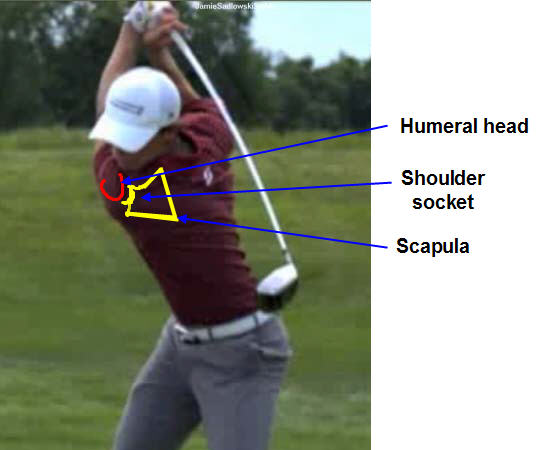
Jamie Sadlowski at his end-backswing position - capture image from his swing video [3]
The yellow-colored, triangular shaped object roughly reflects the position of his left scapula and left shoulder socket joint. The red colored object roughly reflects the position of his left humeral head. The fact that Jamie Sadlowski can i) turn his shoulders ~110 degrees and ii) pull his left scapula far away from his spine and iii) pull his left humeral head away from the glenoid fossa of his left shoulder socket joint - allows him to get his left upper arm to nearly the 12 o'clock position (without increasing his degree of internal rotation of his left upper arm).Another biomechanically important feature of his end-backswing position is the fact that he has acquired a perfect reverse-K posture. He has maintained his rightwards spinal tilt unchanged during his backswing and he has simply rotated his upper torso perpendicularly around his rightwards tilted spine. Even though he has torqued his upper torso to a 110 degree shoulder rotation, he has not allowed this upper torso torquing action to cause his upper torso to lean leftwards into a reverse-pivot posture due to the upper torso's torquing "effect" on the mid-upper thoracic spine. His upper thoracic and cervical spine are still oriented-to-the-right (and they remain in sympathetic alignment with his lower thoracic and lumbar spine), and his upper torso is slanted away from the target. I think that it is biomechanically advantageous to torque-spiral the entire spine in a smooth-spiral fashion without allowing the mid-upper thoracic spine to acquire a lateral "kink" towards the target (thereby producing the reverse-pivot posture that is characteristic of stack-&-tilt golfers).
Jamie Sadlowski is in a perfect position to start his downswing action - i) he has coiled his upper torso against the resistance of a more limited lower torso rotation into a perfect reverse-K position; ii) he has kept his left arm tightly "connected" to his upper torso despite his club-overswinging action; and iii) he has has acquired a phenomenal amount of clubhead lag.
Downswing:
Jamie Sadlowski starts his downswing in a "standard" manner that is characteristic of a left arm swinger who uses a pivot-driven swing - he starts from the bottom-up with a pelvic shift-rotational movement.
Jamie Sadlowski's early downswing - capture images from his swing video [3]
The above series of photos shows Jamie Sadlowski's early downswing motions (by definition, the early downswing ends when the left arm is parallel to the ground).One can see that he first shifts-rotates his pelvis so that his pelvis becomes square to the ball-target line by the end of the early downswing. The left-lateral shift of the pelvis is not a pelvic slide motion - any visual impression of a left-lateral slide motion of the pelvis (as seen from a face-on view) is merely a visual impression that is due to the fact that he is re-weighting his left leg as the left buttocks is pulled back towards the tush line. That re-weighting action causes the left knee to move left-laterally, and this left knee movement gives him a characteristic "sit-down" look when the pelvis becomes square to the ball-target line. During this hip squaring action, which produces his "sit down" look, his pelvis is simply rotating without any left-lateral sliding (look at the left-most part of his white belt and note that it doesn't move more leftwards during the early downswing - although the left knee moves more leftwards).
Note that there is very little delay between the rotation of his pelvis (lower body) and the rotation of his shoulders (upper body). Note that his shoulders are already rotating in image 2. There are many golf instructors/theorists who believe in the kinetic link theory - the theory that "energy" is passively transferred from the rotating lower body upwards to the upper torso when the lower body decelerates and that this "energy" causes the upper torso to rotate (according to the principle of the "Conservation of Angular Momentum"). I personally believe that there is no scientific evidence to support that theory, and I believe that Jamie Sadlowski's upper torso is rotating in the early downswing (prior to any pelvic deceleration) due to the active contraction of mid-upper torso muscles.
Note that the left arm/clubshaft is moving at the same speed as the rotating shoulders during most of the early downswing phase - images 2, 3 and 4 - and that phenomenon accounts for the fact that the distance between his hands and right shoulder is not increasing during this early phase of his downswing. In other words, his hands are being pulled down to the ball between image 1 and image 4, but the pull-force is derived from the fact that the left shoulder is moving downwards-and-forwards, and there is no independent left arm/hand pulling action. In other words, it's his pivot-drive action (rotation of the upper torso) that is pulling his left arm downwards-and-forwards in the direction of the ball, and this biomechanical phenomenon represents the activation of PA#4. It is during this early phase of the downswing that the left arm becomes energised with enough thrust-energy to be blasted towards impact at a very fast speed. The first sign that the left arm is travelling faster than the rotating upper torso is visible in image 5 - note that the angle between the left arm and the chest wall, and the distance between the hands and right shoulder, is starting to increase, and this represents the start of the release of PA#4.
Note that his right elbow is moving down to its pitch location in front of the right hip due to an active adduction movement of the right upper arm towards the right side of the torso, and note that the right elbow remains bent at a 90 degree angle during the early downswing. This active movement of the right upper arm ensures that he keeps the power package intact - the power package consists of the loaded left arm flying wedge and loaded right forearm flying wedge - and keeping the power package intact helps him to keep his clubhead lag (angle between the left arm and clubshaft) unchanged during the early downswing.
PA#4 is released during the mid-downswing, followed shortly thereafter by the centrifugal release of PA#2.
Jamie Sadlowski's mid-downswing - capture images from his swing video [3]
This series of mid-downswing images shows the release of PA#4 - note that the angle between the left arm and chest wall, and distance between the hands and right shoulder, is steadily increasing during the mid-downswing. The reason that PA#4 starts releasing in the last phase of the early downswing (or early phase of the mid-downswing) is due to the fact that the left shoulder is changing its vector of directional motion from being downwards-and-forwards in the direction of the ball to being forwards-and-upwards (as the shoulders become square to the ball-target line and the left shoulder becomes higher than the right shoulder).
During the mid-downswing (during the release of PA#4), his left arm is freewheeling at a very fast speed towards impact. Note that he keeps the right forearm flying wedge's relationship to the left arm flying wedge unchanged during the mid-downswing, which means that he must be actively adducting his right upper arm towards the right side of his torso (note how the gap between his right upper arm and right side of his torso steadily decreases in width during the mid-downswing). When his hands reach the delivery position (image 4), note that his power package remains intact, and note that there has been no straightening of his right elbow during the mid-downswing. His right elbow has reached its pitch location in front of the right hip when his hands reach the delivery position (image 4).
Note that he first starts to lose his amazing amount of clubhead lag in the late phase of the mid-downswing - images 3 and 4 - and this phenomenon is due to the fact that PA#2 is now passively releasing due to a centrifugal action. The timing of the passive centrifugal release of PA#2 is dependent on when the left hand changes its direction of travel from a "straightish" direction (that is directed mainly down towards the ground) to a vector-direction that is directed more towards the target. In TGM conceptual-terms, his left hand starts to go around the end-pulley of the "endless belt system" in images 3 and 4, and the *size of the end-pulley determines the speed of club release [4].
(* the physics of the club release phenomenon is complex and difficult to understand - I have discussed it in great detail in my How to Maximize Wrist Lag and Avoid Casting review paper).
The club continues to release in his late downswing.
Jamie Sadlowski's late downswing - capture images from his swing video [3]
Note how the club continues to release in the late downswing, and note how the left forearm and clubshaft get into a straight-line relationship by impact. The club release phenomenon (representing the release of PA#2) is passive and entirely due to a centrifugal action. The right arm/hand is not supplying a push-force ("hit" force) during the late downswing. One can see his right arm straightening and one can see his right wrist bend diminishing during the late downswing, but that doesn't mean that his right arm/hand is applying a push force to the grip end of the club that moves the grip end of the club faster than it is being pulled forward by the freewheeling left arm/hand (which is traveling at an incredibly fast speed in the late downswing). Note that his right elbow remains in its pitch location (in front of the right hip) throughout the late downswing, and the right forearm is simply paddlewheeling towards impact. It is not biomechanically possible to produce a powerful push-force with a right forearm paddlewheeling action if the right elbow remains in a "fixed" pitch elbow location, and the right elbow can only straighten with enough active isotonic force in the late downswing to allow the right hand to keep up with the left hand.Note that the back of his left hand and dorsum (back) of his left forearm remain parallel to the ball-target throughout the entire late downswing, which means that his left hand is not rotating into impact. In other words, the absence of any left forearm supinatory rotational movement means that there is no hand roll-over action in his late downswing (no involvement of PA#3). Note how the clubface is relatively square to the clubhead arc in image 1, and the clubface remains constantly square to the clubhead arc throughout the remainder of the late downswing (images 2, 3 and 4). There is no release swivel action in Jamie Sadlowski's late downswing action.
Note how his left arm starts to bend ("chicken-wing") as he enters the late downswing phase (image1), and that it is maximally bent at impact (image 4). Why does Jamie Sadlowski's left arm "chicken-wing" at impact?
There are a number of biomechanical factors that are synergistically responsible for Jamie Sadlowski's "chicken-winging" phenomenon. To better understand the phenomenon, compare Tiger Woods and Jamie Sadlowski at impact.
Tiger Woods and Jamie Sadlowski at impact - capture images from their driver swing videos
There are two major differences between Tiger Woods and Jamie Sadlowski at impact.Difference number 1:
Both golfers tee their ball just ahead of low point, so that their clubhead can be moving very slightly upwards at impact. In these two images, the clubhead is at the low point of its clubhead arc. Note that Tiger Woods' left shoulder socket is directly straight-in-line with his low point. However, Jamie Sadlowski has more secondary axis tilt (upper torso tilt away from the target) at impact, and his left shoulder socket is a few inches behind his low point location. I suspect that Jamie Sadlowski has more secondary axis tilt so that he can maintain his balance during his very fast downswing action, but a side-effect of a large amount of secondary axis tilt is the fact that the left shoulder socket will be behind low point at impact.
Difference number 2:
Note that Tiger Woods left arm is straight and in a neutral position. By neutral position, I mean that the left humerus is neither internally rotated or externally rotated, and the left forearm is neither supinated or pronated. That allows the back of Tiger's flat left wrist/hand to face the target at impact. When the left upper arm is in the neutral position, then the elbow joint will also be in a neutral position - as seen in the following anatomical drawing.
Elbow joint - anatomical drawing
When the left arm is in its neutral position, then the alignment of the bones of the elbow joint will appear as seen in the above anatomical diagram. Note that the olecranon process of the ulna bone fits in a groove (olecranon fossa) in the back of the humerus bone. That prevents the ulna bone from moving side-to-side when the elbow joint is fully extended. That allows a golfer, who has an extended/straight left arm, to keep the left arm straight at impact - without using any muscle forces. The elbow becomes "locked" when it is extended, and it resists any side-to-side bending (chicken-winging).Note that the anatomy of the elbow joint allows the ulna bone to articulate with the humerus bone, so that the ulna bone can freely move in only one-plane at the level of the elbow joint - the vertical plane of flexion/extension (presuming that the humerus bone is neither internally rotated or externally rotated).
Note that Jamie Sadlowski has an internally rotated left humerus at address, in the late downswing, and at impact - note that the dorsum (back) of his left forearm and back of his left hand is facing the ball-target line (parallel to the ball-target line), and it is roughly 90 degree rotated away from the target during the late downswing and at impact. That means that his left elbow joint is re-oriented in such a way, that the axis of elbow flexion/extension motion is in-line with the target (parallel to the ball-target line). That will allow "forces" to bend the left elbow if the forces are operating in the same plane of left elbow flexion/extension. I have noted that Jamie Sadlowski's left elbow first starts to bend when his right elbow reaches its pitch location alongside the right hip area - when his right upper arm becomes jammed against the right side of his torso. I suspect that when the right upper arm/elbow reach those positions, that they are slightly restricted in their capacity to move forward in the direction of the target at a very fast speed, and they therefore offer a small level of impedance to the forward motion of the hands. In the early phase of the late downswing, the left arm is still moving in the direction of the target at a very fast speed. However, as the late downswing evolves, the left shoulder socket stops moving in the direction of the target because Jamie starts to arch his torso away from the target as he acquires an increased degree of secondary axis tilt. Therefore, one can conceive of his left arm being restrained at both ends (in terms of forward motion towards the target) - at the level of the hands and at the level of the left shoulder socket. The mid-section of his left arm - the area around the left elbow joint - can then temporarily move slightly faster than the ends of his left arm, and that causes his left elbow to bend slightly at the left elbow joint. In other words, his "bent left elbow" lead his hands into impact. Jamie Sadlowski limits the amount his left elbow bends in the late downswing by actively/isometrically contracting the flexor muscles (biceps muscle and brachialis muscle) of his left upper arm.
Jamie Sadlowski's impact alignments - capture image from his swing video [3]
At impact, he only has a small degree of left elbow flexion, which allows his left forearm and clubshaft to be in a straight line relationship, and to also be vertical with respect to low point - this unusual anatomical alignment of his left shoulder socket (red x), left upper arm, left elbow (red x) and left forearm/clubshaft (yellow lines) ensures that his clubhead/clubface will be square to the ball at the exact moment of ball impact.
What is particularly interesting about Jamie Sadlowski's "bent left arm phenomenon" is the fact that he maintains exactly the same degree of "left elbow bend" well beyond impact.
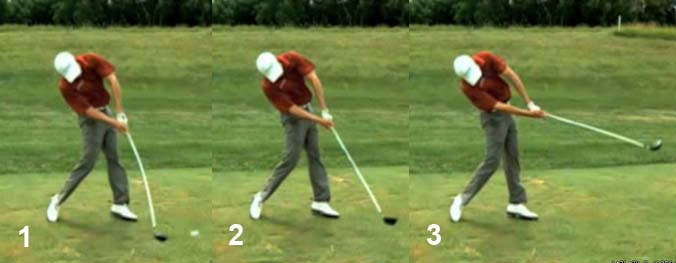
Jamie Sadlowski's followthrough - capture images from his swing video [3]
Note that his degree of "left elbow bend" remains unchanged during the entire followthrough. In fact, he maintains this same degree of "left elbow bend" well beyond the followthrough phase of his swing.
Jamie Sadlowski's swing - capture images from his swing video [3]
Note how he maintains the same degree of "left elbow bend" well after the followthrough phase of the swing is completed. In image 1, his right arm is now fully straight and his right wrist has fully straightened. However, his left arm is still internally rotated in the left shoulder socket joint, and his left elbow is still bent. Note how actively his left upper arm flexor muscles are contracting to maintain that same degree of "left elbow bend". The red arrow points at a "linear bulge" on the inside of his left upper arm, and that bulge is due to his actively contracting brachialis muscle, which is actively/isometrically contracting and thereby keeping the left elbow joint "fixedly" bent to a small degree.
Muscles of the anterior compartment of the arm (front of the arm)
There are two major muscles in the anterior muscle compartment of the upper arm - the brachialis muscle and the biceps muscle. Those two muscles insert into the proximal (central) end of the ulna bone - see blue arrow - and when they actively contract, they flex the elbow joint. The red arrow points at the lower end of the brachialis muscle (which has been fully exposed by retracting the overlying biceps muscle), which will produce a "bulge" along the inner arm when that muscle is actively/forcefully contracting.There are significant biomechanical/mechanical repercussions that are secondary to the fact that Jamie Sadlowski keeps his left arm internally rotated and his left elbow "fixedly" bent well beyond impact. Note how his left wrist becomes markedly bent (markedly dorsiflexed) in the followthrough and early finish phase of his swing.
Jamie Sadlowski's early finish phase - capture images from his swing video [3]
In image 1, his clubshaft is at the 4th parallel, and his right arm is fully straight and his right wrist is fully straightened. His right wrist becomes passively straightened because he runs-out-of-right arm - note that his right shoulder is still far back due to the fact that he still has an extraordinary amount of secondary axis tilt at the end of his followthrough. His left elbow is still bent, and there is no external rotation of the left humerus (as occurs in a traditional left arm swinger's horizontal hinging action and finish swivel action). Note that his left wrist is significantly bent (dorsiflexed) in image 1, and note that it becomes increasingly bent back as the clubshaft swings further around during the finish phase of his swing.
Jamie Sadlowski's mid-late finish phase - capture images from his swing video [3]
What is amazing about Jame Sadlowski's swing is the fact that he continues to keep his "left elbow bent" to the same degree throughout the finish phase of his swing, and the astonishing fact that he is capable of bending his left wrist back to such a remarkable degree (see image 2). He does not use the "standard" left elbow folding action (requiring a left elbow folding/fanning action and a left forearm supinatory movement) that allows a golfer to perform a standard finish swivel action during the finish phase of the swing.His biomechanical actions in the followthrough/finish are very different to the biomechanical actions employed by traditional left arm swingers - as exemplified by Tiger Woods in the following photos.

Tiger Woods' followthrough action - capture images from his swing video
Note that Tiger Woods keeps his left arm straight throughout the followthrough. Note that he also keeps the left wrist flat and the left wrist doesn't bend (dorsiflex). The flat left wrist/hand rotates counterclockwise due to external rotation of the left humerus in the left shoulder socket (causing the left upper arm, left forearm, flat left wrist/hand and clubshaft to rotate at the same rpm). Note that the clubshaft remains in-line with the straight left arm during the followthrough, and the clubshaft does not flip (bypass the left arm) when the right arm straightens.Another characteristic feature of Jamie Sadlowski's downswing is the arching of his spine (away from the target) in the late downswing, and the fact that he maintains that marked degree of secondary axis tilt throughout the followthrough. His torso only becomes more erect during the mid-late finish phase of his swing. I presume that he adopts that marked degree of secondary axis tilt to ensure that he maintains his balance during his super-fast downswing pivot action (while his arms/clubshaft are catapulted at a super-fast speed in the direction of the target).
Consider his head movements during his swing.
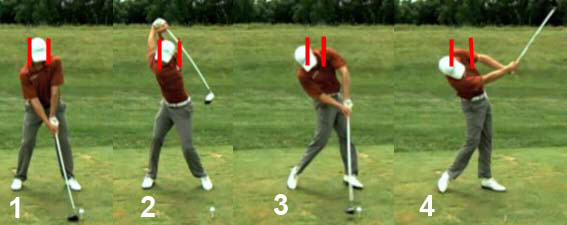
Jamie Sadlowski's head movements - capture images from his swing video [3]
I placed two red lines alongside his head at address (image 1).Image 2 demonstrates how he allows his head to swivel to the right during the backswing. That head swiveling action is very desirable, and characteristic of a golfer who adopts a reverse-K end-backswing position.
Image 3 shows how much his head drops during the downswing - due to the increased degree of rightwards spinal tilt (secondary axis tilt) that he acquires during his downswing.
Image 4 demonstrates that his head drops even further post-impact - this is unusual, and I presume that it is due to the fact that he needs to be leaning away from the target to maintain his balance. Jamie Sadlowski only weighs 165lbs and he does not have the body mass to ground himself soldily on the turf - like Jason Zuback (another long-drive champion) - and I presume that his lithe/pliant torso and flexible spine have to arch away from the target so that he can maintain his balance during the downswing and followthrough.
Jamie Sadlowski's swing also demonstrates that it is a myth that one has to have a large positive O factor (left hip rise) in the late downswing to generate a lot of swing power. Jim McLean promoted this idea as part of his triple X-factor theory [6] and I discussed this "hip rise" concept in my review paper on Jim McLean's Triple X-factor: A Critical Review. Robert Baker also promoted the same idea in his O-factor concept as being important for both swing power and ball flight accuracy [7]. Note that Jamie Sadlowski's pelvis remains relatively horizontal throughout the downswing, and his left hip is only slightly higher than the right hip at impact. The reason why he can maintain a relatively horizontal pelvis despite a straight left leg at impact (which causes the left pelvis to rise) is the fact that he lifts up his right heel and gets well up onto his right foot's toes during his downswing, and that causes his right pelvis to become higher than it otherwise would be if he simply rolled his right foot inwards (like most professional golfers). A positive O factor does make it easier for a golfer, who has an inflexible spine, to acquire a greater degree of secondary axis tilt in the downswing, but Jamie Sadlowski has an ultra-flexible spine that bends backwards in an arc-like manner during his downswing, thereby allowing him to acquire an extraordinary amount of secondary axis tilt without any need for a large positive O factor. When a golfer pivots over a straight left leg at impact (thereby causing the left pelvis to rise), it merely reflects the presence of swing power. The biomechanical phenomenon of a "left hip rise" at impact should be perceived to be a marker of swing power, rather than being perceived to be a critically important biomechanical generator of swing power.
Swing comparison to another long-drive champion - Jason Zuback.
I think that Jamie Sadlowski has near-perfect swing biomechanics due to an optimised pivot action. I personally think that his pivot action is much better than Jason Zuback's pivot action, and I believe that it is a major factor responsible for his extraordinary long-driving performance.Consider Jason Zuback's pivot action - http://www.youtube.com/watch?v=Izmb_3F0y88
Note that Jason Zuback promotes the S&T swing methodology where a golfer is advised to rotate around an imaginary centralised pivot axis. Jason Zuback states a golfer should not sway and he recommends that a golfer should simply rotate around a centralised pivot axis, while keeping the head centralised (vertically in-line with that centralised pivot axis). However, I believe that this S&T swing methodology can actually promote a pelvic sway motion, as can be seen if one carefully analyses Jason Zuback's body motions during his backswing and downswing.
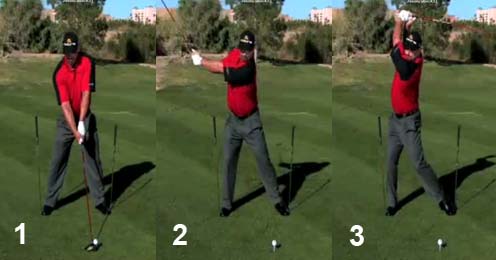
Jason Zuback's backswing pivot action - capture images from his swing video
Image 1 shows Jason Zuback at address - note that his pevis and head are centralised (with respect to those two vertical shafts placed alongside the outer border of his right foot and left foot).Image 2 shows Jason Zuback performing his version of a centralised backswing pivot action - where he tries to keep his head centralised and where he tries to rotate around an imaginary centralised pivot axis. Note how much he has swayed his pelvis, and mid-torso, rightwards.
Image 3 shows Jason Zuback at his end-backswing position. Note how much he has swayed his pelvis, and mid-torso, rightwards. Also, note how his upper spine, and upper torso, are tilted leftwards in the direction of the target. I think that he is reverse-pivoting, and I have labelled this type of backswing pivot action a leftwards-centralised backswing pivot action (see my review paper on Optimal Weight Shift in the Full Golf Swing for further details on a leftwards-centralised backswing pivot action versus a rightwards-centralised backswing pivot action).
Compare his leftwards-centralised backswing pivot action to golfers who have a rightwards-centralised backswing pivot action.
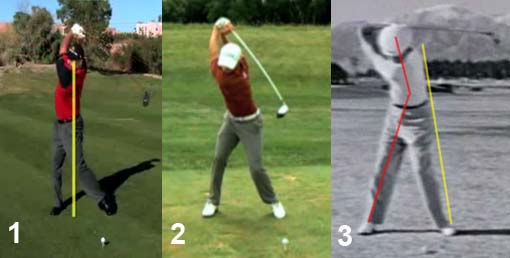
Composite photo of three golfers' backswing pivot actions
Image 1 shows Jason Zuback rotating around an imaginary centralised pivot axis (yellow line). Note how he acquires the reverse-pivoting posture of a golfer who adopts a leftwards-centralised backswing pivot action.Image 2 shows Jamie Sadlowski, and image 3 shows Ben Hogan, at their end-backswing position. Both of these golfers use a rightwards-centralised backswing pivot action, which causes them to acquire a reverse-K posture at the end of the backswing. Note how they do not allow their pelvis to sway rightwards during the backswing, and they are simply rotating their upper torso around their rightwards-tilted spine - without any lateral swaying motion of their lower or upper torso.
What are the consequences of a leftwards-centralised backswing pivot action? Consider Jason Zuback's downswing pivot action.
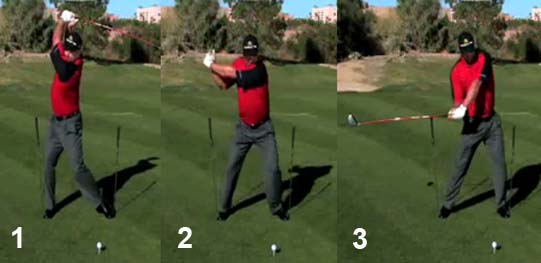
Jason Zuback's early-mid downswing - capture images from his swing video [3]
Image 1 shows Jason Zuback at the end-backswing position - note that his pelvis has swayed to the right, while his upper torso/spine are leaning leftwards.Image 2 shows Jason Zuback at the end of his early downswing. Note that he has swayed his pelvis to the left, and this significant degree of left-lateral pelvic shift motion has "corrected" his upper torso/spinal tilt so that he now has a rightwards tilted spine.
Image 3 shows Jason Zuback in mid-downswing, when his hand reach waist level - note that he has lost a significant amount of clubhead lag.
I believe that there is causal connection between the left-lateral pelvic sway motion (needed to "correct" the reverse-pivoting [left-leaning] upper body posture) and a loss of clubhead lag.
Consider an example of how a small degree of reverse pivoting in a superb amateur golfer, who has a rightwards-centralised backswing pivot action, can decrease his degree of clubhead lag.

Anonymous amateur golfer - capture images from his swing video
In the first swing (images 1 & 2), note how he has allowed his upper torso/spine to acquire a small degree of left-leaning (small degree of reverse pivoting) by the end of his backswing. Note that he has lost a significant amount of his clubhead lag by the end of the early downswing (image 2). By contrast, in his second swing (images 3 &4), he has the classical reverse-K posture at the end of his backswing (image 3). Note how he retains an incredible amount of clubhead lag by the end of his early downswing (image 4) . My personal opinion is that any left-leaning motion of the upper torso/spine during the backswing requires a compensatory "corrective" motion in the early downswing that causes the hands to momentarily move slightly backwards (directly away from the target) and I suspect that it predisposes to casting.
Conclusion:
I think that Jamie Sadlowski has near-perfect swing biomechanics if one considers his swing solely from a swing power perspective.His strong points, from a swing power perspective, include the following biomechanical/mechanical phenomena.
1) He has a superb backswing/ downswing pivot action. He stays very centralised when he performs a backswing pivot action and there is no swaying of his lower or upper torso during his backswing pivot action. He uses a standard rightwards-centralised backswing pivot action where he simply rotates his upper torso around a rightwards tilted spine, and he acquires a perfect reverse-K posture by the end of his backswing. His backswing pivot action is "tight" and "compact" and he has no "loose parts", and he maintains a close "connection" between his rotating torso and his arms (even though his arms/clubshaft over-swings). He performs the downswing pivot action flawlessly - starting with a pelvic squaring action, which is followed immediately by an active upper torso rotation. His arms/clubshaft respond instantaneously to his downswing pivot action, and there is remarkable synchrony between his body's rotational motions and the movement of his arms/clubshaft across the front of his rotating torso. His downswing pivot action is so efficient that he can retain an amazing amount of clubhead lag to a late time-point in his mid-downswing. His downswing pivot action is so fast and so fluid, that he can release PA#4 with maximum speed and efficiency. He also releases PA#2 passively/centrifugally with extraordinary efficiency, and his superfast clubhead speed (145+mph through impact) is optimised/maximised by the combination of i) an amazing amount of clubhead lag and a ii) super-efficient release of PA#2.
2) He has ultra-flexible left/right wrist joints that allow him to acquire an amazing amount of clubhead lag by the end of his backswing. His ultra-flexible left wrist joint, combined with a strong left hand grip and an internally rotated left arm, allows him to pull the clubshaft downwards-and-forwards through the impact zone with no need for a release swivel action, and no need for a horizontal hinging action (in the followthrough). That means that he is perfectly mimicing the movement of the central arm in a double pendulum swing model (eg. Iron Byron-style golf swing machine). His rhythm and timing are impeccable and he squares his clubface at impact. I suspect that the lack of any hand-rollover action (release of PA#3) makes it easier for him to consistently square the clubface - considering the speed of his super-fast downswing arm/clubshaft motion. His swing has a few atypical biomechanical features (internally rotated left arm, strong left hand grip) that causes his left arm to be slightly bent at impact. However, this personal swing idiosyncrasy is actually very advantageous from a swing power perspective, because it allows him to have more secondary axis tilt at impact (his left shoulder is a few inches behind low point), which he presumably needs in order to keep his body in balance during his superfast downswing action.
Jeff Mann.October 2009.
References:
1. Jamie Sadlowski's official website.
2. RE/MAX 2008 World Championship event.http://www.youtube.com/watch?v=qWc461rvPwA
http://www.youtube.com/watch?v=TMY4envK9V4&NR=1
3. Slow motion swing video of Jamie Sadlowski's swing.http://www.youtube.com/watch?v=EZ0dNIP-yoU
Here is a better version without any commentary by Peter Kostis.
http://www.youtube.com/watch?v=ep-qidwgCII
4. The Golfing Machine. Homer Kelley.
4. Applying Physics to Golf. David Tutelman.http://www.tutelman.com/golf/design/swing1.php?ref=
5. Swing Like a Pro. Ralph Mann and Fred Griffin.
6. Triple X-factor. Jim McLean. Golf Digest. January 2008.
Abbreviated version available online at http://www.golfdigest.com/instruction/swing/2008/01/mclean_xfactor
7. Robert Baker's O factor concept.
Available at http://www.golf.com/golf/video/article/0,28224,1595277,00.html
